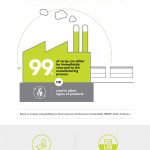Vinyl Siding Eco-Friendly Benefits, Part II: The Superior Recycling Advantages
When I was asked by VSI to start a blog series on learning the eco-friendly benefits of vinyl siding from a lay person’s perspective, my first reaction was how do I make an argument for plastic as a sustainable material? But when I did my research for my first blog back in October, I learned that vinyl siding is not a throwaway plastic. It’s actually a durable thermoplastic, and there’s a difference.
Thanks to the VSI’s Sustainability Work Group, I discovered from their “facts and science” approach that vinyl siding has a multitude of eco-friendly features, and is a more sustainable product than just about any other material used for building exteriors. What impressed me the most was the fact that vinyl siding yields virtually no waste during the manufacturing process.
If you focus in on vinyl siding’s ability to be reground and made into new product – especially during the manufacturing process – you will see that the industry actually raised the bar with landfill diversion best practices established as long ago as the 1970s.
Like me, the average person assumes that because vinyl is a plastic, it’s not a recyclable product, and goes to the landfill regularly. On the contrary, vinyl siding is actually a durable thermoplastic, which means that it was designed for “recycle-ability.”
“Thermoplastic has the ability to be formed into a part or object and ground and re-formed,” asserts Richard Krock, Vice President, Regulatory and Technical Affairs at The Vinyl Institute (VI). “The ‘thermo’ implies that material can be re-ground and re-processed into another thermoplastic.”
“At the end of the day, there is no material sent to the landfill,” according to a leading manufacturer.
“In our facilities, materials that are manufactured out of spec do not get scrapped. They are put into our re-grind. In this process, you chop up the vinyl siding into pellet form and that material is put into the back ply of a future product.”
Essentially, all vinyl siding consists of back ply and top cap (co-extrusion). The top cap is virgin material exposed to weather. And the back ply is partially re-ground from other material previously manufactured out of spec.
According to the leading manufacturer, the re-grind process is common throughout the industry, and has been in existence for more than 40 years, as long as co-extrusion was introduced.
As far as exteriors go, vinyl siding is an industry leader since their manufacturers were the first to incorporate re-grinding and co-extrusion processes, and continue to be highly-efficient practitioners whereas some materials do not allow for these capabilities.
“When you think of other claddings, think about eggs,” said Susan Wade, Vice President of Marketing & Communications for the Vinyl Institute. “When you boil an egg, you cannot re-boil it.” Cement board, for example, cannot be re-ground.
Vinyl siding’s co-extrusion advantages have also wielded post-consumer recycling opportunities.
Several companies have produced vinyl siding using post-consumer manufactured vinyl.
Richard Krock holds that the interior of vinyl gutters are made from recycled substrates.
Post-consumer recycled vinyl has increased by 40% since 2014.[i]
But again, vinyl siding’s biggest win is the landfill diversion through its re-grinding process. There is little or no post-manufacturing waste – a claim that no other cladding producers appear to be making in their marketing communications.
It is amazing to me how easily vinyl siding can be recycled. What is more impressive is the industry’s commitment to continuously improve its waste management efforts through re-use.
“There have been significant improvements over the past 20 years,” claims Christian Barcan, Vice President, Sustainability & Industry Affairs for the VI.
To amplify Barcan’s point, of all the materials discarded into municipal solid waste in 2012, less than 1% was from the overall vinyl industry. Imagine how minuscule the rate of vinyl siding is given the effective recycling practices from the manufacturers.[ii]
According to Barcan, the council has created the V-Cycle Task Force, which is a collaboration of the VI, the VSI, and industry leaders like Dhruv Raina, Director of Sustainability for Tarkett.
When I think of vinyl siding’s robust history of durability, long life, manufacturers’ focus on eliminating waste, regrinding bad runs of product, recyclability, the ease and efficiency of recycling vinyl compared to other home materials, and their steadfast commitment to continuous improvement in the sustainability arena, the vinyl industry is in a league of their own.
There is recycling, and there is VINYL SIDING RECYCLING!
[i] Tarnell Company VI Survey, Sold Amounts. 2017 [ii] “RECYCLING AS A SUSTAINABILITY PRACTICE IN THE NORTH AMERICAN VINYL INDUSTRY”
Richard Krock, The Vinyl Institute, Stephen Tarnell, Tarnell Company, LLC, 2015.
Don Browne is a writer and entrepreneur who believes that the power of words can change the world. He provides unique writing services for clients in the construction, health care, IT and hospitality sectors. He has a passion for small business and start-ups, as well as writing about Irish history, family and corporate biographies. As a homeowner and father of four, Don looks forward to writing more about sustainability issues within the housing industry.


